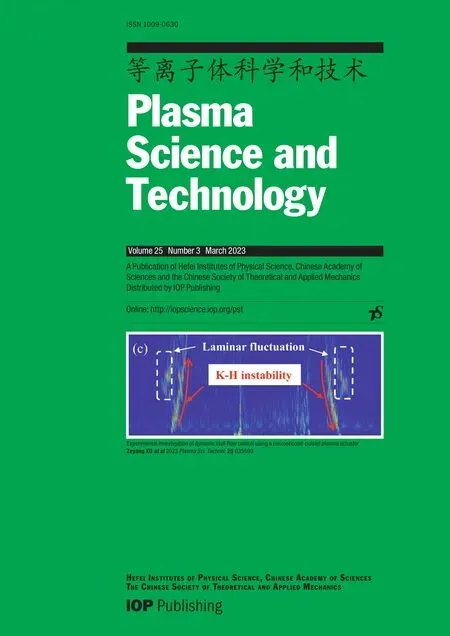Experimental investigation on de-icing by an array of impact rod-type plasma synthetic jets
2023-03-15XuechengLIU刘雪城HuaLIANG梁华HaohuaZONG宗豪华LikeXIE谢理科andZhiSU苏志
Xuecheng LIU (刘雪城), Hua LIANG (梁华),*, Haohua ZONG (宗豪华),Like XIE (谢理科) and Zhi SU (苏志)
1Science and Technology on Plasma Dynamics Laboratory, Air Force Engineering University, Xi’an 710038, People’s Republic of China
2 School of Mechanical Engineering,Xi’an Jiaotong University,Xi’an 710049,People’s Republic of China
Abstract Since flight accidents due to aircraft icing occur from time to time,this paper proposes an array of impact rod-type plasma synthetic jet de-icing methods for aircraft icing problems.The impact rod-type plasma synthetic jet actuator(PSJA)is based on the traditional PSJA with an additional impact rod structure for better de-icing in the flight environment.In this work,we first optimize the ice-breaking performance of a single-impact rod-type PSJA, and then conduct an array of impact rod-type plasma synthetic jet ice-breaking experiments to investigate the relationship between crack expansion and discharge energy, ice thickness and group spacing.The results show that the impact force and impulse of a single-impact rod-type PSJA are proportional to the discharge energy,and there exists a threshold energy Qmin for a single actuator to break the ice,which is proportional to the ice thickness.Only when the discharge energy reaches above Qmin can the ice layer produce cracks, and at the same time, the maximum radial crack length produced during the ice-breaking process is proportional to the discharge energy.When the ice is broken by an array of impact rod PSJAs, the discharge energy and group spacing together determine whether the crack can be extended to the middle region of the actuator.When the group spacing is certain, increasing the energy can increase the intersection of cracks in the middle region, and the ice-fragmentation degree is increased and the ice-breaking effect is better.At the same time, the energy estimation method of ice breaking by an array of impact rod-type PSJAs is proposed according to the law when a single actuator is breaking ice.
Keywords: plasma de-icing, plasma synthesis jet, force measurement, high-speed photography,ice cracks
1.Introduction
The flight safety of aircraft can be affected by aircraft icing,and the presence of icing at different component locations can lead to different safety impact factors.Therefore, the study of aircraft anti-icing technology has received extensive attention[1-4].For example, when icing occurs on the wings of an aircraft, the lift and rudder efficiency of the aircraft will drop sharply,leading to an uncontrolled crash;icing on the engine intakes or blades will significantly weaken the engine thrust and cause flight safety accidents; when icing occurs on the instruments and sensors of an aircraft,the pilot will not be able to judge the flight status of the aircraft correctly,which will easily cause incorrect operation and lead to flight accidents.Aircraft anti/de-icing technology plays a pivotal role in flight safety,and research on aircraft anti/de-icing technology is necessary.An existing mechanical anti-icing method [5, 6] is to generate mechanical force in the aircraft protection area by means of electricity, pneumatics or acoustic waves to destroy the ice accumulation structure and make the accumulated ice fall off from the aircraft surface or remove the residual ice under the action of pneumatic force.This is mainly represented by pneumatic boot de-icing and electric pulse de-icing.When de-icing using the pneumatic boot system,the expansion tube will damage the aircraft aerodynamic profile,etc,which will increase the drag.A pneumatic boot system can deteriorate over time and needs to be checked periodically for stability of performance.The electric pulse de-icing process applies repeated impact loads.However, this can cause a significant structural fatigue problem with the aircraft.The impact rod-type plasma synthetic jet actuator (PSJA) studied in this paper is used to break the ice by the impact force of the impact rod, which is also considered to be one of the mechanical deicing technologies.It has the advantages of simple structure,low energy consumption and fast response time compared to the current pneumatic boot system de-icing and electric pulse deicing.Thermal anti/de-icing is divided into gas-thermal anti/deicing technology [7-9] and electric anti/de-icing technology[10, 11].The former introduces high-temperature gas from inside the engine through a pipe to the area where anti-icing is needed, and the latter buries the heat pipe or heat sheet in the surface of the area where anti/de-icing is needed,and the heat is transmitted to the surface of the aircraft through the surface to achieve the effect of anti/de-icing.At present, thermal anti/deicing technology is the most widely used, but still has some disadvantages.Gas-thermal anti/de-icing technology has a negative impact on the efficiency of the engine,and the energy utilization rate is not high;electric anti/de-icing technology has a complex heating system structure and low heat transfer efficiency.In addition, there is also chemical liquid anti-icing,which is a specially formulated chemical liquid applied to the part that needs anti-icing, and mixes with the chemical liquid when the supercooled liquid droplets hit the surface to lower its freezing point, thus achieving an anti/de-icing effect [12, 13].
In summary, there are various existing anti/de-icing technologies, but they all have their own shortcomings, so new anti/de-icing technologies are emerging.For example,plasma anti/de-icing technology has become a research hotspot [14-20].With in-depth research of dielectric-barrier discharge(DBD)plasma in the field of active flow control,its remarkable thermal properties have attracted attention in recent years and started to be widely used in plasma anti/deicing technology [21, 22], which plays an important role in the field of plasma anti/de-icing.Researchers have conducted a significant amount of research in the field of anti/de-icing using DBD plasma and have achieved great results [15-17].However, research on plasma synthetic jet anti-icing is in its infancy.The PSJA, a new zero-net mass-flow actuator that uses an arc discharge to generate a high-speed jet, was proposed by the Applied Physics Laboratory at Johns Hopkins University in 2003[23].The PSJA has the advantages of high jet velocity, fast response time, wide actuation band and no moving parts [24-27].It has been studied extensively in the field of active flow control.In recent years, due to its simple structure, low energy consumption and fast response time, it has also attracted the attention of some researchers and has been introduced into the field of anti/de-icing.In 2020, Gao et al conducted the first de-icing study based on plasma synthetic jets to break up ice under static conditions using a high-speed jet ejected from the actuator,and recorded the icebreaking process using a high-speed camera[18].In 2021,the team proposed a de-icing strategy that combines plasma synthetic jets with electrical heating, using electrical heating to break the bonding force of the ice first,and then turning on the PSJA for de-icing [19].To meet the requirements of inflight de-icing, Gao et al [20] adapted the structure of the PSJA, designed a new plasma striker for experimental validation of de-icing, and investigated the effect of the parameters of the moving parts on the performance of ice breaking.The ability of the colliding rod PSJA to de-ice has been verified,but the study of an individual actuator to break the ice is not detailed enough.Meanwhile, the study of array colliding rod PSJA de-icing is necessary to ensure that the ice on the wing is completely removed.This paper mainly focuses on the above issues to carry out research.The first is to study the impact force and impulse generated by a singleimpact rod PSJA with different parameters by force measurement, and also to study the maximum radial crack length produced by a single actuator when breaking ice with different discharge energies and ice thicknesses.The second is to study the effect of ice breaking by an array of impact rod-type PSJAs under different group spacings and discharge energies,and to propose an estimation method of ice-breaking energy by an array actuator.
2.Single-impact rod-type PSJA efficiency optimization
2.1.Experimental setup and test system
The experimentally used impact rod PSJA is a mechanical device added to the structure of a typical two-electrode PSJA,which consists of four parts: cavity, electrode, top cap and impact rod,and the top cap is set up with two air filling holes.The schematic and physical diagram of the structure of the impact rod-type PSJA is shown in figure 1.Because the actuator cavity is in a relatively confined high-voltage and high-temperature environment, it is required that a material with good insulation performance be chosen, with highvoltage breakdown resistance and strong arc ablation resistance.Therefore,the ceramic material alumina(Al2O3)is used to process the actuator cavity.The top cover and the impact bar are made of polyether ether ketone resin (PEEK).The cavity height of the actuator is 10 mm, and the diameters are 6, 8 and 10 mm in order to study the discharge effect under different cavity volumes.A 1.2 mm diameter hole is drilled 3 mm above the bottom of the inner cavity, and two 1 mm diameter tungsten needles can be inserted into the hole as electrodes.The electrode spacing is 4,5 and 6 mm in order to study the discharge effect under different electrode spacings.The internal cavity of the top cover is 14 mm in diameter and 20 mm in height to meet the reciprocating motion of the impact rod, which corresponds to the center hole of the top cover with a diameter of 6 mm, and there is a hole 2 mm in diameter in the middle and top of the internal cavity of the top cover to provide air replenishment.The bottom of the impact rod is a disc with a diameter of 13.6 mm and a height of 3 mm, and the upper part is a round rod with a diameter of 5 mm and a height of 19 mm, both of them being one whole.According to Gao et al [19], the smaller the mass of the impact rod, the better the ice-breaking effect under the premise of meeting the stiffness requirement.Thus, PEEK material, with a mass of only 1.1 g, was chosen for processing.

Figure 1.Schematic diagram and physical drawing of the structure of the impact rod-type PSJA.
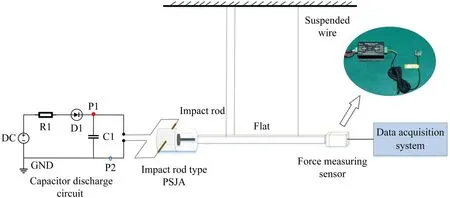
Figure 2.Schematic diagram of the force measurement experimental setup.
Since the impact rod-type PSJA exerts impact force on the ice layer mainly by mechanical devices, it is necessary to measure the impact force of the impact rod.In order to measure the magnitude of the impact force generated by the ramrod at different energies,a schematic diagram of the force measurement experimental setup is built,as shown in figure 2.
As shown in figure 2 from left to right are the capacitor discharge circuit, impact rod-type PSJA, suspended wire plate device,force-measuring sensor and data acquisition system.The capacitor discharge circuit is used to drive the impact rod PSJA.The circuit uses a high-voltage DC power supply with a maximum output voltage of 30 kV and a rated power of 8 kW,with input overload short-circuit protection and output overvoltage and overcurrent protection.The current-limiting resistor R1 has a resistance value of 1.5 kΩ and a rated power of 400 W.The energy storage capacitor has a withstand voltage of 12 kV and capacitance values of 1,2,3 and 4 μF,respectively.The highvoltage diode is used to isolate the capacitor charging circuit and the actuator discharging circuit to prevent damage to the power supply by reverse current overload with a withstand voltage of 60 kV and a current limit of 20 A.Since the plasma synthesis jet generates electromagnetic interference when it is discharged, a suspended wire plate device is built between the force-measuring sensor and the actuator, and the force is conducted by the suspended plate to avoid the influence of electromagnetic interference on the measurement results.The suspended wire is a steel wire with a length of 1 m and a diameter of 1 mm,and the flat plate is an acrylic plate with a length of 30 cm, a width of 20 cm and a thickness of 5 mm.They both meet the experimental requirements in terms of strength and toughness.The force-measuring sensor selected for this experiment is the model AT8301 pull-pressure force-measuring sensor with high dynamic response frequency,rated capacity of 1 N and 150%F.S.(Full Scale)safety overload.The TDA-02C analog transmitter is selected to convert the output signal of the force-measuring sensor into a voltage signal and then connected to an oscilloscope for display and acquisition,with an output accuracy of less than 0.2% and a sampling frequency of 40 SPS (sample per second).Considering that the ramrod is hitting in close proximity to the ice,the experiments are conducted with the actuator ramrod close to the plate side, while the distance between the other side of the plate and the force-measuring sensor is kept within 1 mm to ensure the accuracy of the force measurement.The data acquisition system consists of an oscilloscope, a voltage probe and a current monitor.A high-voltage probe (Tektronix P6021A,DC voltage:0-20 kV,pulse peak-peak voltage:0-40 kV) is used to measure the voltages at both ends of the positive and negative electrodes of the actuator, and a current coil (Pearson 110 A, pulse peak-peak current: 0-10 000 A) is used to measure the current of the discharge loop.The collected voltage-current waveforms are displayed and stored by an oscilloscope (Tektronix DPO4104B).The locations of the measurement points of the high-voltage probe and current coil are marked with P1 and P2,respectively,in the circuit diagram in figure 2.The oscilloscope is set in DC-coupled mode,and the stored waveform consists of 1 M data points at a time.
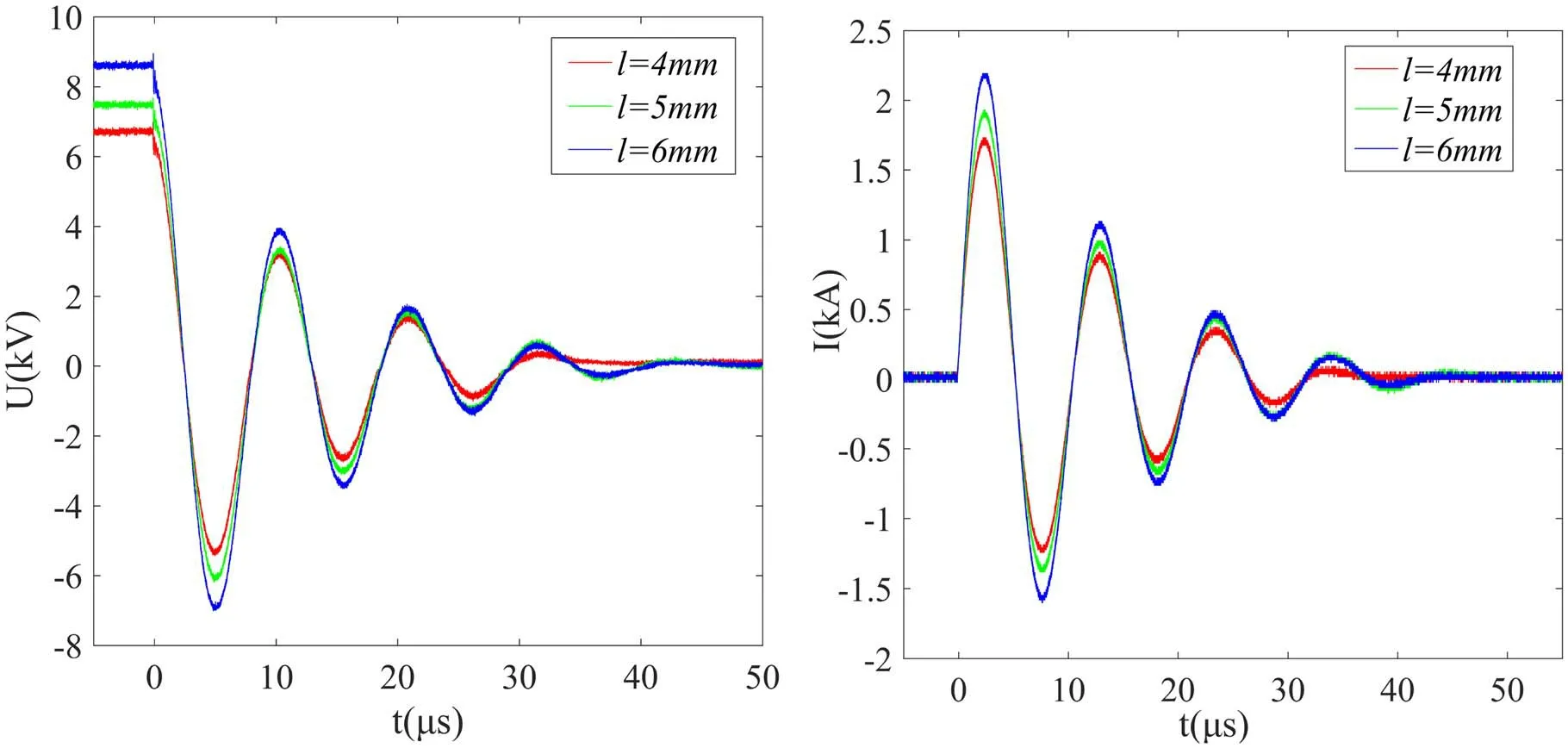
Figure 3.Voltage-current waveform at different electrode spacings (a=10 mm, C=1 μF).
2.2.Measurement results of electrical parameters and force
In the experimental process,the high-voltage DC power supply is adjusted to form a potential difference between the cathode and anode ends of the actuator,thus forming a spatial electric field in the air medium in the cavity of the actuator.When the electric field strength reaches the air breakdown voltage, the actuator discharges instantaneously, rapidly heating the gas in the cavity,and the pressure and temperature of the gas in the cavity rise sharply.The high-temperature and high-pressure gas in the actuator cavity rapidly expands and pushes the impacting rod forward.After the impact rod hits one side of the plate, the impacting force is transmitted to the force sensor on the other side of the plate,and finally the change in the impacting force during the discharge process is recorded by the oscilloscope.During the discharge process, the oscilloscope also records the voltage-current waveform,which is used to analyze the electrical parameter characteristics of the actuator.The effects and laws of different parameters on the impact rod-type PSJA were further analyzed by changing the cavity volume, electrode spacing and capacitance size.Figure 3 shows the voltage-current waveforms at different electrode spacings with a cavity diameter of 10 mm and a capacitance of 1 μF.When the circuit is turned on, the voltage across the capacitor rises rapidly until it reaches the gas breakdown voltage,followed by a rapid drop in voltage and a rapid rise in current.During the discharge process, the voltage-current shows an oscillating decay change,and the oscillation periods of voltage-current waveforms at different electrode spacings are approximately equal.As can be seen from the figure, the breakdown voltage increases with the increase in electrode spacing,and the breakdown voltages are 6.78, 7.54 and 8.64 kV for 4, 5 and 6 mm electrode spacings l, respectively.The peak currents also gradually increase with the increase in electrode spacing,and the peak currents are 3.43, 3.78 and 4.35 kA for 4, 5 and 6 mm electrode spacings l,respectively.The change in electrode spacing has a small effect on the discharge time scale,and the duration of one discharge is about 45 μs.
The capacitance energy, i.e.the energy stored in the capacitor, Ec, can be calculated by equation (1):
where C is the capacitance value and Ubis the breakdown voltage.
The discharge energy Q can be obtained by integrating the voltage and current collected by the oscilloscope through equation (2):
Therefore, the discharge efficiency η at different electrode spacings and capacitance values under the same cavity volume can be obtained by equation(3),as shown in figure 4.It can be seen from the figure that the discharge efficiency increases with the increase in electrode spacing and capacitance value.
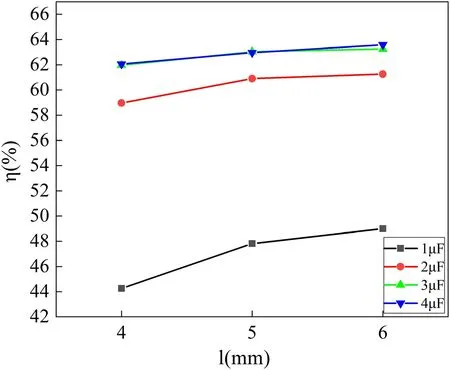
Figure 4.Discharge efficiency at different electrode spacings and capacitance values (a=10 mm).
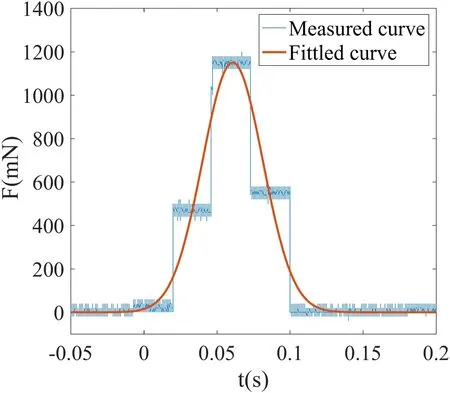
Figure 5.Impact force generated by the impact rod-type PSJA.
The impact force on the impact rod measured by the force measurement sensor and the fitted values are shown in figure 5.It has been shown in related studies that the dynamic pressure inside the plasma synthesis jet cavity can rise to several MPa within a hundred μs [19], indicating that the force exerted on the impinging rod will also rapidly become large.However, the analog transmitter with an acquisition frequency of 40 SPS has difficulty in capturing the complete change process of the impact force, so the measurement curve of the impact force can be seen in the figure in a stepped form, and then the fitted curve of the impact force can be drawn by fitting the actual measurement curve in real time with time.The experimental measurement shows that with the increase in electrode spacing or capacitance, the peak impact force measured by the force measurement sensor can increase from 300 to about 1200 mN, and the result shown in the figure is that the peak impact force is around 1100 mN.The ice-breaking is a dynamic process in which the force is applied from the time the impact rod touches the ice surface, and the load on the ice increases as the force becomes larger until the ice breaks up.The ice-breaking process is a dynamic process in which the force is applied from the time the impact rod touches the ice surface,and the load on the ice increases as the force becomes larger until the ice breaks up.The magnitude of the impulse Ipis the main influencing factor in this dynamic process.Since the impact force measured by the force-measuring sensor is stepped,it is equivalent to the smoothing of the transient impact force,which has little effect on the calculation of the impulse amount and can ensure the accuracy of the impulse amount.Therefore, this force sensor can basically meet the requirements of the current experiment.
In order to better illustrate the effect of the impact force,the impulse during a single discharge of the impact rod-type PSJA can be obtained by equation(4).The impulse represents the continuous effect of the impact force to crack and expand the ice layer in a certain time,and is related to the mechanical energy of the impact rod.The larger the impulse, the larger the mechanical energy.

Figure 6.Impulse at different cavity volumes and electrode spacings.
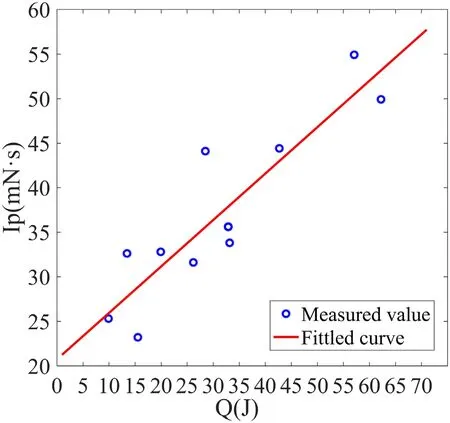
Figure 7.Impulse of the impact rod-type PSJA at different energies.
In order to optimize the ice-breaking effectiveness from the change of actuator geometric parameters, the effect of cavity volume on the impulse volume for the same actuation parameters was investigated.Figure 6 shows the impulse volume for different cavity diameters and electrode spacings at a fixed capacitance value of C=1 μF.By controlling the electrode spacing and capacitance size to ensure the same actuation parameters, the cavity diameter is changed so that the cavity volume is changed.In this work, three different actuator cavities are selected for the experiment.The horizontal coordinates are the cavity diameters of 6, 8 and 10 mm, the cavity heights are 10 mm and the corresponding cavity volumes are 283.74, 502.66 and 785.40 mm3, respectively.From figure 4, it can be seen that as the electrode spacing becomes larger the discharge efficiency first increases and then tends to a stable value.Since the discharge efficiency of L=6 mm is similar to that of L=5 mm, only the experiments with electrode spacing L=4 and 5 mm were conducted in this study.
From figure 6, it can be seen that the impulse does not become larger with the increase in the cavity diameter at the same electrode spacing,but shows a different pattern,with the cavity diameter of 8 mm corresponding to the smallest impulse.The preliminary analysis is that the cavity volume determines the gas volume and jet velocity, and these two parameters together affect the motion of the impact rod and impulse during the impact.The cavity of 6 mm diameter has a large jet velocity, and the gas volume of 10 mm diameter is large, so the impulse generated by the cavity of 8 mm diameter is larger than that of 8 mm diameter.
In order to more intuitively relate the discharge energy input to the actuator to the converted mechanical energy,force measurement experiments were performed at different actuation parameters, and the impulse of the impact process was obtained by integrating the measured impact force.Figure 7 shows the impulse at different discharge energies obtained by changing the electrode spacing and capacitance size under the cavity diameter of 10 mm, and it can be seen that the larger the discharge energy, the larger the impulse,while fitting the data can get the universal relationship between the impulse and the discharge energy, and the equation of the fitted curve is,
3.Single-actuator ice-breaking crack extension length study
3.1.Ice-breaking experimental system
The experimental system of ice breaking with a colliding rod PSJA is shown in figure 8, which is mainly divided into a discharge system, a data acquisition system and an icebreaking platform.The discharge system consists of a capacitor charging loop and a high-voltage pulse breakdown loop for the purpose of controlling the actuator to achieve discharge for ice breaking at different energies.The high-voltage DC power supply of the capacitor charging circuit charges the capacitor to establish a potential difference between the anode and cathode of the actuator,but this potential difference is not enough to achieve breakdown of the gas between the anode and cathode.The high-voltage pulse breakdown circuit outputs a high-voltage pulse,which is up to tens of kilovolts,but the current and power are small, and it is only used to establish a discharge channel between the trigger electrode and the cathode to achieve the energy release for achieving a larger power of the DC power supply.
This experiment studies the ice-breaking effect of one discharge of the actuator.The data acquisition system mainly includes the acquisition of voltage and current waveform by oscilloscope and the recording of the high-speed camera process by computer.The voltage probe and current monitor are placed at P1 and P2 for measurement, respectively.The rising edge signal is sent to the oscilloscope for triggering through the current monitor,and the oscilloscope is triggered and then sends a signal to the high-speed camera for triggering.The high-speed camera was placed horizontally above the ice-breaking platform,with a shooting speed of 28000 fps and an exposure time of 30 μs.The light was incident into the high-speed camera through a 45° fixed reflecting mirror to achieve the shooting of the ice layer, and a 200 W LED light was selected as the fill light source.
The ice-breaking platform is mainly composed of a sliding platform,a fixed base and an acrylic plate.A 3D view of the ice-breaking platform is shown in the elliptical dashed line in figure 8(a).The sliding platform can adjust the group spacing of the array actuators,the fixed base is used to fix the actuator cavity and realize the movement on the sliding platform,and the acrylic plate is used to place the ice layer.At the same time, the upper surface of the acrylic plate and the top cover of the actuator are sprayed with matte black paint to facilitate the high-speed camera to clearly capture the cracking and development process of the ice layer.Since the effect of ice breaking by an array of impact rod-type PSJAs is to be studied in the experiment,a long strip of ice layer is prepared for the experiment.The experiments were performed by premaking ice and then covering the ice layer over the actuator for ice breaking.The ice container was made of rubber material by stamping and grinding,and the inner cavity was a rectangular body 20 cm in length,10 cm in width and 2 cm in height.The thickness of ice is controlled by water injection,the density of the water is 0.917 g cm-3,and the ice layer with thicknesses of 3, 4 and 5 mm can be prepared when volumes of the water injection are 65.1,86.8 and 108.5 ml.The waterfilled rubber container is placed horizontally in a freezer with adjustable temperature, and the freezer temperature is adjusted to -10 °C.The freezing time is not less than 10 h.The prepared ice layer is removed from the rubber container and then put into the freezer for 1 h to reduce the impact caused by removing the ice.After the discharge system and the data acquisition system have been set up,the ice layer is taken out and placed on the acrylic plate for the experiment.The experimental process is extremely short,while the main study of this work is the generation and expansion of cracks in the ice-breaking process,which is a macroscopic phenomenon,so the ice layer is slightly affected by the surrounding temperature.The small changes in the ice layer do not have much impact on the experimental results, so the experiment can be carried out normally.
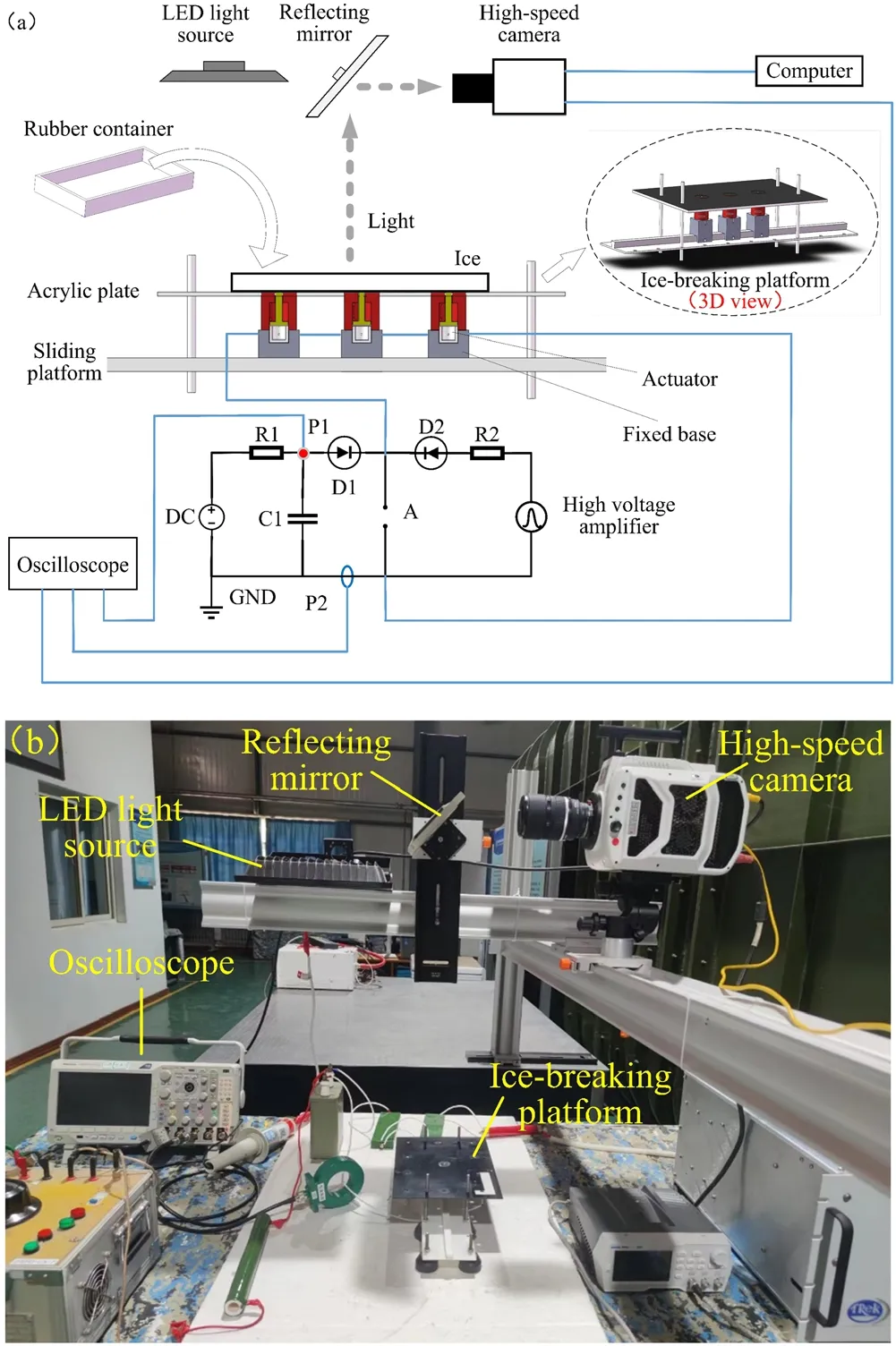
Figure 8.Experimental system for ice breaking by impact rod-type plasma synthesis jet: (a) schematic diagram and (b) physical diagram.
3.2.Study of crack extension length during ice breaking by a single actuator
Previous studies on ice-breaking have been conducted from load conditions [28], while ice breaking by an impact rodtype PSJA is more of a completely new study from an energy perspective, both from different angles but both essentially the same.According to the force measurement experiments obtained in the previous section, the impulse at the impact of the actuator impact rod is proportional to the energy, and it can be obtained that the load exerted by the impact rod on the ice is also proportional to the discharge energy.Therefore,the discharge energy, which is more intuitive and easier to calculate quantitatively,is used instead of the applied load as the control variable.

Figure 9.Ice-breaking process of a single-impact rod PSJA.
In this section, the relationship between the ice-crack extension length of a single actuator and the ice thickness and discharge energy is studied first.The ice thicknesses are 3, 4 and 5 mm,respectively,and the discharge energy is regulated by the capacitor charging circuit.The specific magnitude of the discharge energy can be calculated by integrating the voltage-current during the discharge process.As shown in figure 9, the ice thickness D=5 mm and the discharge energy Q=14.50 J are used in the ice-breaking process of the actuator, and the red circle is the point of action of the impact rod.When t=0 s,we can see that the plasma light is generated when the actuator is discharged, and the gap between the top cover of the actuator and the acrylic plate and the impact rod are illuminated by the plasma light.Subsequently, the gas inside the cavity heats up and expands, and the impact rod starts to move upwards to hit the ice layer under the pressure inside the cavity.According to the literature, for non-adherent ice, radial cracking occurs when the maximum tensile stress exceeds the tensile strength limit of the ice [29].Cracks start to appear in the ice layer at t =350 μs.After that, the ice cracking begins to rapidly expand,and at t=385 μs it is a radial crack with distinctive features.From the vicinity of the impact point to the edge of the ice,the stress gradually decays and the crack density decreases.At t=455 μs the crack extension ends and there exists a radial crack of maximum length, whose length is denoted by Lmax.
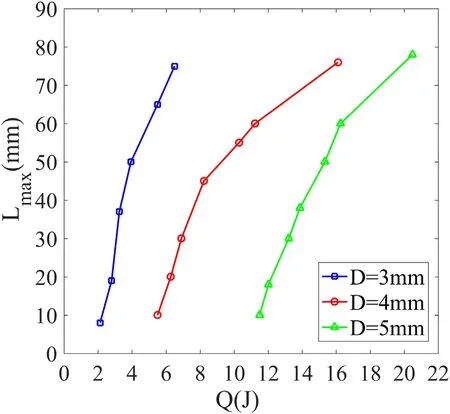
Figure 10.Maximum radial crack length versus discharge energy and ice thickness.
It was found in the experiments with different ice thicknesses and in the related literature that when the discharge energy is satisfied that the ice can be cracked but not too much, the cracking is mainly radial cracking.If effective de-icing can be achieved by generating radial cracks only,this will help to reduce energy consumption.This is because the generation of circumferential cracking requires a larger load and a greater discharge energy than radial cracking [28].Therefore, this experiment focuses on the generation and extension of radial cracks.Under the conditions of the ice size in this experiment, a maximum radial crack, i.e.a crack of length Lmax,exists in the case of ice cracks without extending to the ice edge.Considering the variability of the ice layer and the instability of the discharge, a large number of repeated experiments (more than 20 times for the same conditions)were carried out at the same ice thickness and discharge energy, and the relationship between the maximum radial crack length and ice thickness and discharge energy was obtained after averaging the measured Lmax, as shown in figure 10.It can be seen from the figure that the maximum radial crack length becomes larger with increasing discharge energy for the same ice thickness.There is a threshold energy for cracking the ice layer of different thicknesses, which is recorded as Qmin,and the threshold energy increases with the thickness of the ice layer.
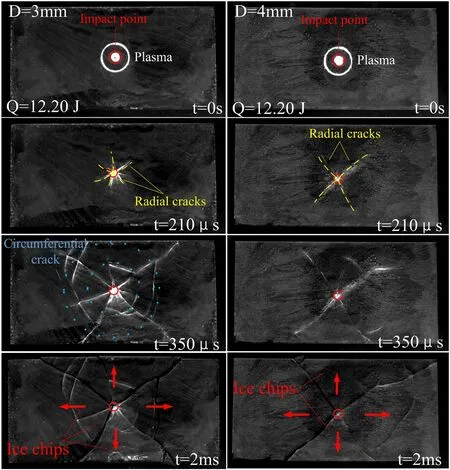
Figure 11.Ice-breaking process of different thicknesses of ice at the same energy.
During the experiment,as the discharge energy continued to increase, circumferential cracks appeared on the basis of the generation of radial cracks.The relevant literature also indicates that the minimum discharge energy for the generation of circumferential cracks is higher than the minimum discharge energy for the generation of radial cracks [29].To illustrate this feature and to compare it with figure 10,experiments were also conducted to compare the crack generation in different thicknesses of ice layers at the same energy.As shown in figure 11, the ice-breaking process is shown for ice thicknesses D of 3 and 4 mm,respectively,at a discharge energy of Q=12.20 J.From the figure, it can be seen that different ice thicknesses with the same energy show different ice-breaking characteristics, and the radial cracks and circumferential cracks are marked with yellow dashed lines and blue dots in the figure,respectively.The left part of the figure is the crack generation and expansion process for the D=3 mm thickness ice layer, and the right part is the crack generation and expansion process for the D=4 mm thickness ice layer.For the ice layer with D=3 mm, the energy of Q=12.20 J is large,so the circumferential crack is generated on the basis of the radial crack, and the circumferential crack further intensifies the ice fragmentation and produces a large number of ice fragments.At t=350 μs when the crack extension ends, several radial cracks can be seen to have extended to the edge of the ice layer, and there are two small and large circumferential cracks at the same time.After the end of crack extension, the ramrod will continue to move upwards, the broken ice pieces will slide in all directions under the action of the ramrod, and the ice pieces sliding in all directions with the crack as the boundary can be seen at t=2 ms.For the ice layer with D=4 mm, it can be seen from the end of crack extension at t=350 μs that it has extended to the edge of the ice layer,and compared to the ice layer with D=3 mm, it can be seen from the case of t=2 ms that the ice fragments are larger but fewer in number.Andrews and Lockington [30] confirmed that the ice breakup energy increases with the thickness under certain conditions, so the thicker the ice layer, the more energy is needed to overcome the ice breakup energy at the same energy,and then the energy used to perform crack expansion and produce more ice fragments is relatively less.As can be seen in figure 10,when Q=12.20 J,the corresponding crack length is above 65 mm, indicating that this energy is capable of producing longer radial cracks,which is consistent with the basic law described in figure 10.
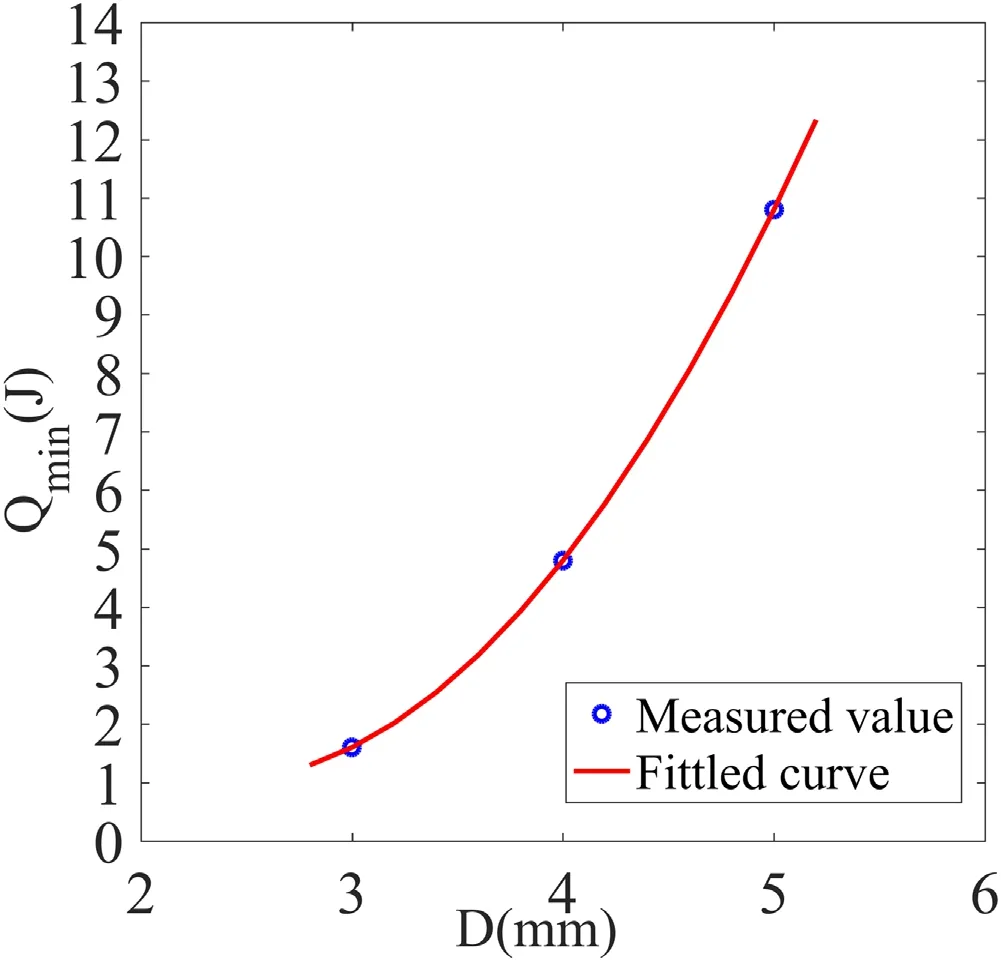
Figure 12.Single-actuator ice-breaking threshold energy versus ice thickness.
The magnitude of the threshold energy Qminfor crack production in the ice layer can be obtained by extending the curve in figure 10 and intersecting it with the horizontal axis.In this experiment, the ice thicknesses D=3, 4 and 5 mm correspond to Qminof 1.5, 4.6 and 10.7 J, respectively, and the relationship between Qminand ice thickness can be obtained by plotting them on a graph,as shown in figure 12.From the figure,it can be seen that the threshold energy that can make the ice layer crack is proportional to the ice thickness, and the fitted curve can be used to obtain the threshold energy Qminfor cracking of different thicknesses of ice, which can guide the selection of discharge energy.
In order to make the law of ice breaking by a single-impact rod-type PSJA more universal, the relationship between ice cracking and discharge energy needs to be dimensionless.The ratio of the maximum radial crack Lmaxto the ice thickness D is used as a dimensionless representation of the ice crack, while the ratio of the discharge energy Q to the threshold energy Qminis used as a dimensionless representation of the discharge energy when cracking the ice.The dimensionless relationship between radial crack and discharge energy is shown in figure 13, where Q/Qminis the horizontal coordinate and Lmax/D is the vertical coordinate.The blue circle in the figure is the actual measured and processed value in the experiment,and the red curve is the fitted curve.It can be seen that as Q/Qminincreases, Lmax/D also increases, and there is a positive relationship between the two parameters.By fitting the curve,two dimensionless functions can be obtained, which can be combined with the law shown in figure 12 to guide the selection of array actuator group spacing and discharge energy.
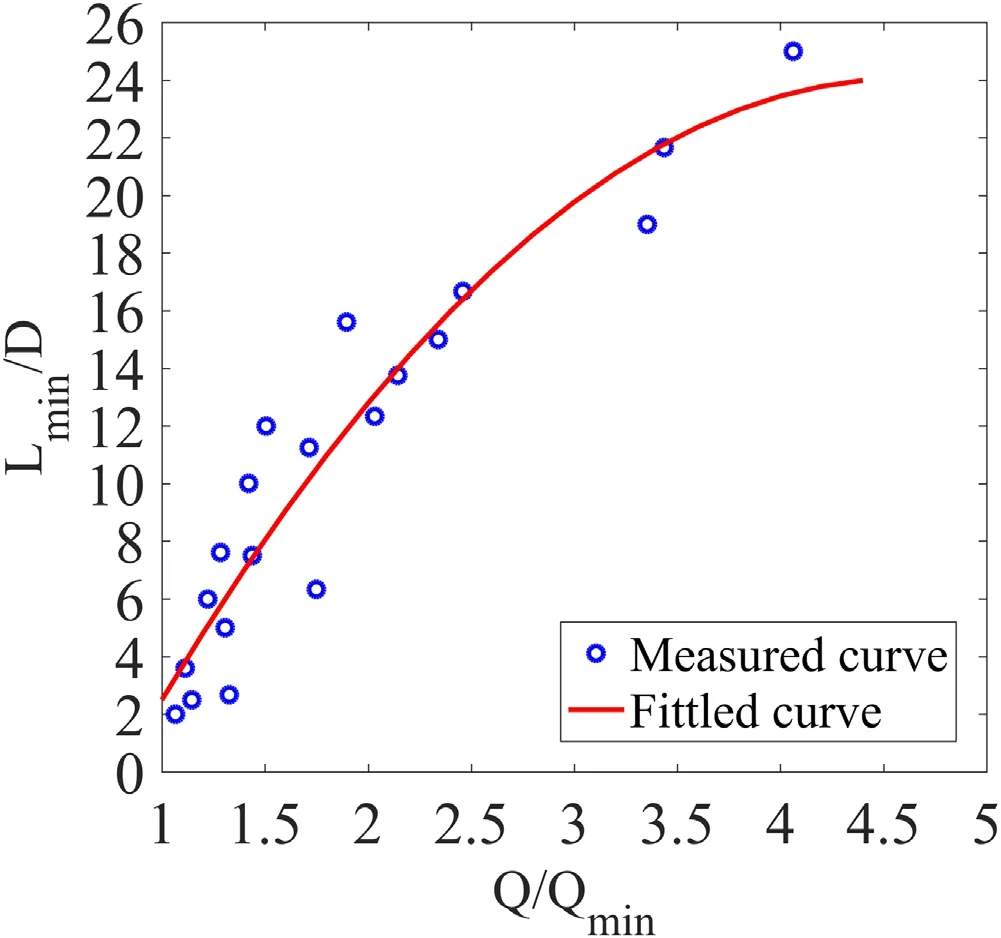
Figure 13.Dimensionless relationship between maximum radial cracking and discharge energy at single-actuator ice breaking.
4.Ice-breaking effect of the array of impact rod-type PSJAs
4.1.Relationship between crack extension area and discharge energy during ice breaking with array actuators
In order to study the effect of array actuators on ice breaking,the effect of discharge energy on the ice-breaking effect needs to be studied first.Since the crack length changes more rapidly with increasing discharge energy when a single actuator breaks the ice,the crack is easily extended to the ice edge.Considering the limitation of ice size, two impact rodtype PSJAs are connected in series and the group spacing d=10 cm is taken to be fixed on the ice-breaking platform for the experiment, and the crack expansion in the middle region of the array actuators is mainly observed.The dynamic process of ice breaking of the array actuators at different energies is shown in figure 14.The discharge energy Q shown in the figure is the average energy after the integration of voltage-current divided by the number of actuators.Figure 14(a) shows the ice-breaking process for Q=6.60 J.From the figure,it can be seen that at t=210 μs,cracks have started to appear at actuator A1, while there is no significant change at actuator A2.This is the phenomenon of successive discharge due to the series connection of actuators, but the interval between the discharges of the two actuators is extremely short,only a few tens of μs,so from the overall point of view,there is no effect on the ice breaking.When t=280 μs,it can be seen that the ice layer at actuator A2 under the impact of the impact rod is compressively damaged[31].The ice layer then started to crack because the stress exceeded the strength limit.The crack extension ends when t=385 μs.It can be seen that the radial crack lengths produced by the two actuators breaking the ice at this energy are small and all break the ice independently in their respective regions,and the cracks do not cross and interact with each other.This leads to a crack-free region in the middle ice layer of the array actuators, which is indicated by the white circles in figure 14(a).As the energy increases to Q=9.11 J,it can be seen in figure 14(b) that the radial crack length from the ice breaking at the two actuators is longer and the crack has extended to the middle region of the array actuators, and there is crossover and interaction effects between the cracks.This is due to the increase in discharge energy leading to an increase in the loading rate,which in turn leads to an increase in the ice strain rate[32].The appearance of cracks in the intermediate ice layer of the array actuators and the appearance of interaction effects of the resulting cracks increased the degree of ice fragmentation,which could produce more ice chips and help the array actuators to perform ice breaking.Continuing to increase the discharge energy to Q=12.80 J, it can be seen from figure 14(c) that at t=385 μs, circumferential cracking of the ice layer appears on the basis of radial cracking.It can be seen from figure 10 that the radial cracking is mainly at this energy,and it is not enough to produce circumferential cracking, so it is clear that the energy required for circumferential cracking to appear under the action of the array actuators decreases.The increase in energy makes the intersection of cracks in the middle region of the array actuators increase and the ice breaks up more violently,which can produce more ice chips.
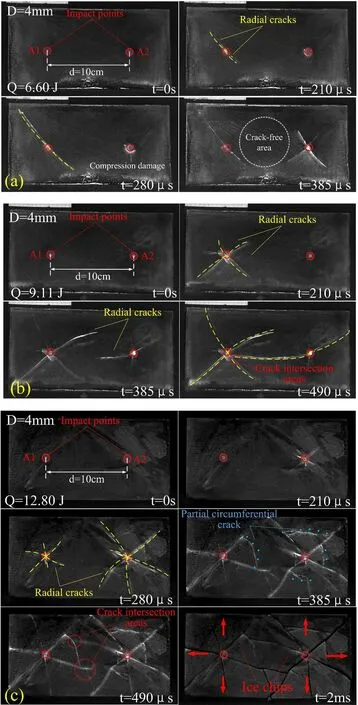
Figure 14.Dynamic process of ice breaking by array actuators at different discharge energies: (a) Q=6.60 J, (b) Q=9.11 J, (c)Q=12.80 J.
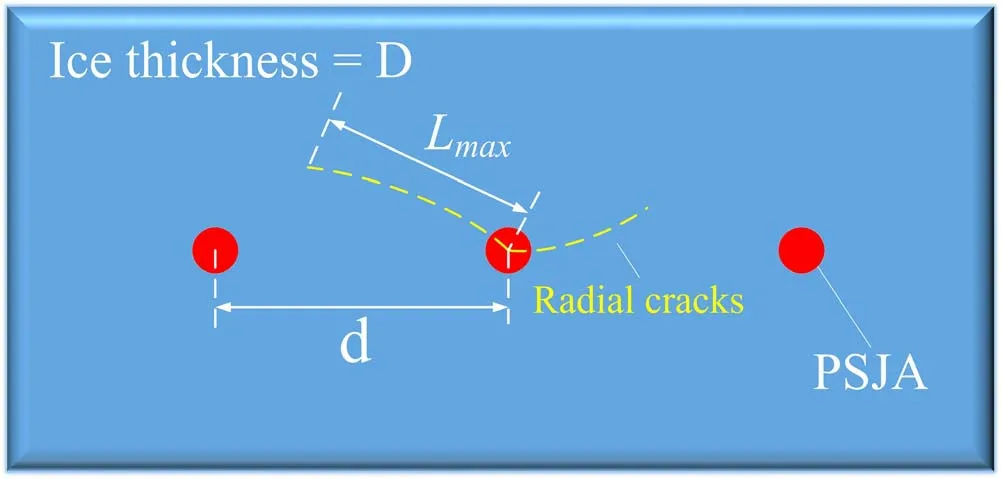
Figure 15.Schematic diagram of the array of impact rod-type PSJAs for ice breaking.
4.2.Array actuator ice-breaking energy estimation method
The above experimental results show that the array actuators have an excellent ice-breaking effect.Moreover, with the same energy of a single actuator, the length of radial cracks becomes larger and the energy of circumferential cracks decreases when the array actuator is breaking ice.At the same time, the ice breaking is more violent and the ice-breaking effect is better.For the array actuators there are two parameters that need to be considered.One is the choice of group spacing, and the other is the choice of discharge energy.Based on the experiment, reducing the group spacing or increasing the discharge energy can achieve a good icebreaking effect.For the array actuator ice breaking, there are two typical working modes under the joint action of group spacing and discharge energy.One mode of operation is that the ice cracks do not extend to the middle region.This is equivalent to each actuator breaking the ice alone, the ice in the area near each actuator is removed, while the ice in the middle area is stored,so that the ice shape can be modulated.Another mode of operation is that the ice cracks can be extended to the middle area, and the cracks generated by different actuators will cross each other, and the whole ice layer will be broken and removed.
Based on the experimental results and laws of ice breaking by a single actuator in the previous section, a preliminary estimation of the group spacing and the selection of discharge energy of the array actuators can be made,which in turn guides the ice breaking by the array actuators.The following case with fixed group spacing ensures that the crack extends to the middle region, thus achieving the minimum energy of the array actuators for estimating the cross influence of cracks on each other as an example to illustrate.A schematic of the array actuator ice breaking is shown in figure 15.The blue rectangle represents the ice layer, and its thickness is denoted by D.The red dot represents the PSJA below the ice layer, and the group spacing is represented by d for an array of three actuators in the figure.The yellow dashed line represents the radial crack produced by the actuator when breaking the ice,where the maximum radial crack length is denoted by Lmax.When the maximum radial crack length is greater than the group spacing, the probability of the above situation is maximum, that is, Lmax> d, then Lmax=d can be taken to estimate the discharge energy required for a single actuator.The thickness of the ice layer is known to be D.The threshold energy Qminfor crack generation in the ice layer at that thickness can be obtained from the relationship between the threshold energy and the ice layer thickness.At the same time,Lmaxand D are known, and Q/Qmincan be obtained from Lmax/D by the dimensionless relationship between the maximum radial crack and the discharge energy.Then, from the obtained threshold energy Qminand dimensionless energy Q/Qmin, the required discharge energy Q for a single actuator can be derived.Finally, multiplying by the number of array actuators, the minimum total energy Qallfor crack extension to the intermediate region and thus the total de-icing can be obtained.
5.Conclusion
This paper presents the following conclusions:
(1) The impact force and the impulse during the impact generated by a single-impact rod-type PSJA are proportional to the discharge energy.The single actuator breaks the ice only after reaching the threshold energy Qmin,and the maximum radial crack produced during the icebreaking process is proportional to the discharge energy,and the threshold energy Qminis proportional to the ice thickness.The dimensionless relationship between the maximum radial crack and the discharge energy is obtained experimentally,which can guide the selection of the group spacing and energy of the array of impact rodtype PSJAs.
(2) When the ice is broken by an array of impact rod-type PSJAs, whether the cracks can extend to the middle region of the actuator is affected by both the discharge energy and the group spacing.When the group spacing is certain, the increase in energy makes more cracks intersect in the middle region of the array actuators,and the ice breaks more violently, which can produce more ice fragments.Compared to single-actuator ice breaking, the energy required for the appearance of circumferential cracks under the action of array actuators is reduced.An energy estimation method for ice breaking by an array of impact rod-type PSJAs is proposed based on the law for ice breaking by a single actuator.
Acknowledgments
This study was financially supported by National Natural Science Foundation of China (No.12002384), National Key Laboratory Foundation of China (No.614220220200107),National Science and Technology Major Project of China(No.J2019-II-0014-0035) and Academician Workstation F0undation of the Green Aerotechnics Research Institute of Chongqing Jiaotong University (No.GATRI2020C06003).
Data Availability Statement
Some or all data,models,or code that support the findings of this study are available from the corresponding author upon reasonable request.
ORCID iDs
猜你喜欢
杂志排行
Plasma Science and Technology的其它文章
- Application of integrated simulation environment SIEMNED to the analysis of the MEPHIST-0 tokamak operation
- Improvement of a temperature response function for divertor heat flux monitoring in fusion devices
- Degradation of sulfamethoxazole in water by dielectric barrier discharge plasma jet:influencing parameters, degradation pathway, toxicity evaluation
- Experimental investigation of dynamic stall flow control using a microsecond-pulsed plasma actuator
- Laser-assisted ablation and plasma formation of titanium explored by LIBS,QCM, optical microscopy and SEM analyses along with mechanical modifications under different pressures of Ar and Ne
- Study on the effect of focal position change on the expansion velocity and propagation mechanism of plasma generated by millisecond pulsed laser-induced fused silica
